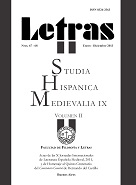Las Prophetiae Merlini de Geoffrey de Monmouth en los Baladros castellanos: estado de la cuestión
Keywords:
Geoffrey of Monmouth, Prophetiae Merlini, Continental spreading, Castilian Baladros, State-of-the-artAbstract
The Historia regum Britanniae (circa 1139) by the Welsh bishop Geoffrey of Monmouth, outstanding text in the Medieval Latin corpus because of its projections both historiographic and fictional, is intended to refer the actions of all Celtic monarchs of Britain before the Germanic conquest. In this purpose, its chapters 112 to 117 are a mise en abîme since the Prophetiae Merlini that can be found there, attributed to the famous magician but inspired by the Old and New Testament apocalyptic literature, reproduce prophetically the main content of the chronic itself, and even anticipate the final restoration of the defeated Celtic people. Although Wace, Chrétien de Troyes and later French novelistic tradition, indebted to the Historia in many respects, rejected the text because of its acute hermetism, it did spread throughout the continent and reappeared surprisingly interpolated, in a Castilian version, within two late books of the Hispanic chivalric genre, the Baladro del sabio Merlín con sus profecías (Burgos, 1498) and the first part of the Demanda del santo Grial (Sevilla, 1535). This paper aims to review the current knowledge about this Castilian version of the Prophetiae and to identify the problems still pending. Fundamental contributions on the Latin original and the French versions —given the plausible hypothesis of a French source for our translation— will be taken into account.Downloads
Download data is not yet available.
Downloads
Published
2019-04-23
How to Cite
Casais, A. (2019). Las Prophetiae Merlini de Geoffrey de Monmouth en los Baladros castellanos: estado de la cuestión. Letras, (67-68), 39–53. Retrieved from https://e-revistas.uca.edu.ar/index.php/LET/article/view/1791
Issue
Section
Ponencias
License












